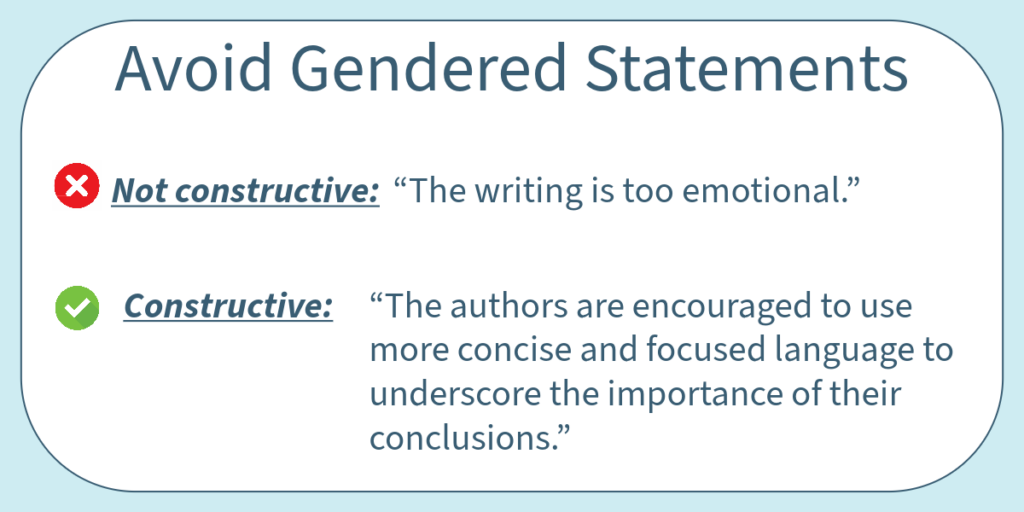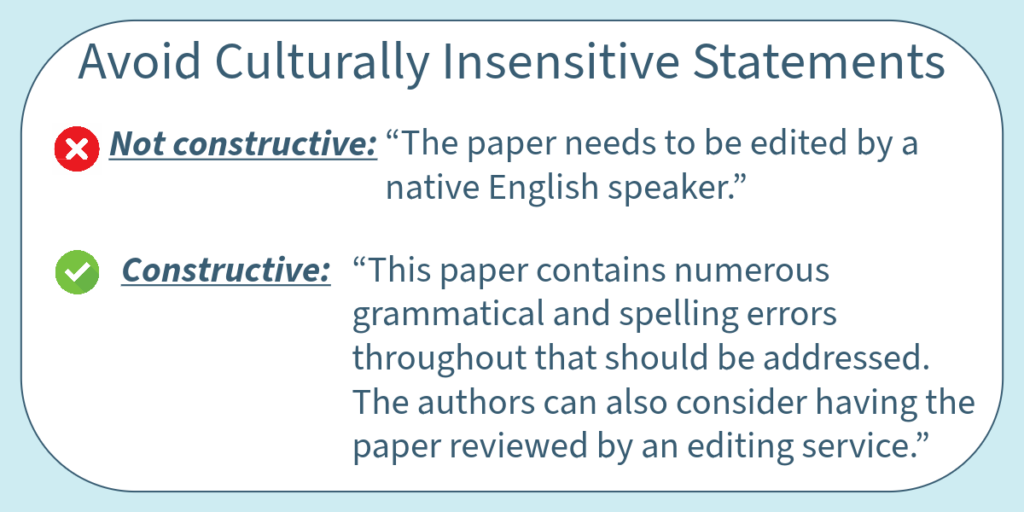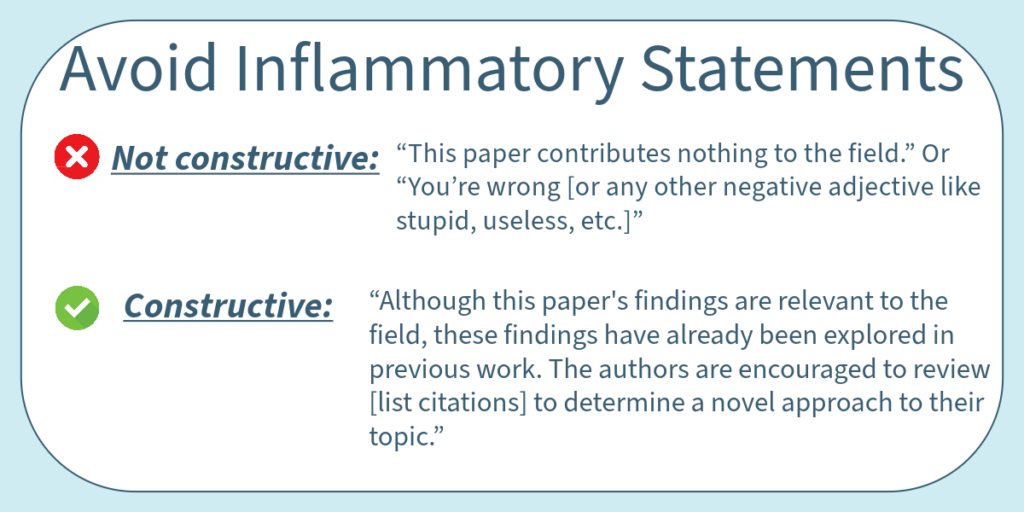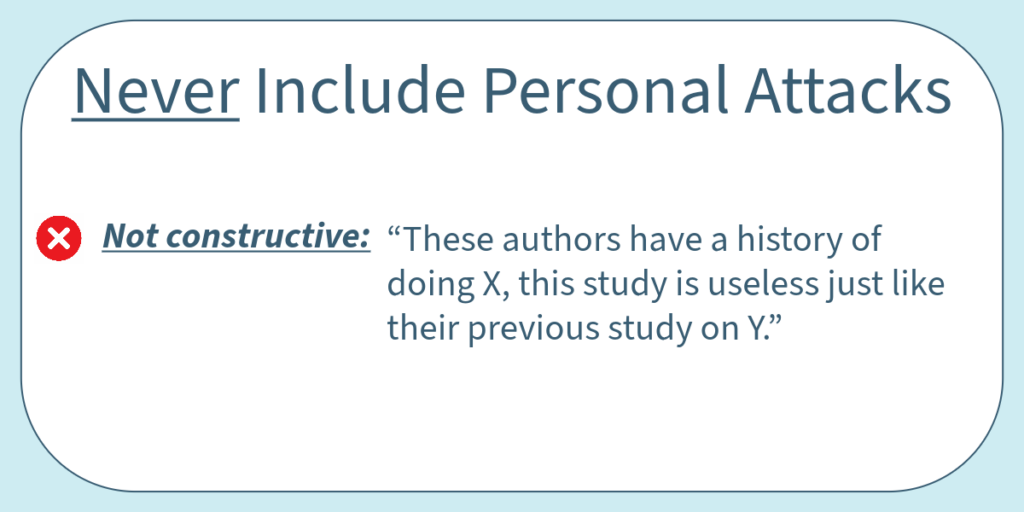Editors’ Vox is a blog from AGU’s Publications Department.
Fair peer review is a necessity for research across all scientific disciplines. Thousands of experts volunteer their time each year to advance scientific understanding and provide feedback to their peers by reviewing manuscripts in AGU’s journals. Whether you are an early-career researcher preparing to review your first manuscript, or a seasoned expert, it is important to understand your role as a reviewer and ensure you provide constructive feedback to authors.
When writing your review, always remember to treat others the way they would like to be treated. Managing your tone and considering unconscious biases is paramount to writing a respectful and helpful review. Here, we’ve put together a quick guide on what to include and exclude from your peer review comments.
What are the key features of a constructive review?
In general, the most helpful review is one that first provides an overall summary of the main contribution of the paper and its appropriateness for the journal then summarizes what major items should be addressed in revision. These can be explained and amplified in further comments or paragraphs. Minor suggestions or edits are best listed separately, citing specific line numbers.
In AGU’s journals, reviewers can also include confidential remarks to the Editor on the reviewer form and also recommend if the manuscript is worthy of additional publicity, if published.
What should reviewers avoid when writing a review?
AGU is committed to an inclusive and equitable scientific publishing environment, which includes minimizing the influence of unconscious biases in the peer review process. Reviewers can do this by:
- Focusing on the research in the article, not the authors’ attributes such as their name, language, institutional affiliation, nationality, and gender
- Being aware of potential unconscious biases that you may have
- Carefully considering the reasons for your recommendation
It is important to avoid:
Vague Statements
Always try to elaborate on what needs to be changed without making judgements about the authors’ efforts. Whenever possible, refer to specific examples and include line numbers where the example can be found in the text.

Commanding Statements
Reviews are best written in the third person to avoid sounding accusatory. Consider how your wording comes across from the authors’ perspective and tailor any language that is accusatory or demanding.

Gendered Statements
Reviews should not include statements that are derogatory or that focus on gender stereotypes instead of the science.

Avoid Culturally Insensitive Statements
It is inaccurate to construe the authors’ English language proficiency as a proxy for the quality of the science in a manuscript. The stage at which a language is learned does not indicate technical proficiency.
If the manuscript has many grammatical, spelling, and editing errors affecting its readability, it’s best to provide a few specific examples (3-5) of the types of errors found in the paper (with line numbers whenever applicable). This will allow the authors to understand and address the errors. There are also editing services that you might recommend to the author, including the American Journal Experts (AJE), where AGU members receive a 20% discount.

Inflammatory Statements
Reviews that make assumptions about the paper without providing specific feedback are not helpful to the author. Review comments should offer guidance to the authors on how they can broaden their research so it may contribute something to the field. The review comments should give the authors actionable feedback.

Making Assumptions About the Authors
Reviews should not call the authors’ qualifications into question. Instead, reviewers should elaborate on where the science or writing is lacking.

Never Include Personal Attacks
Reviews should be unbiased, respectful, and constructive. Personal attacks that call an author’s character into question should never be included in a peer review. If a reviewer cannot ensure this, then they should recuse themselves from the review. If any conflicts of interest are present that could impact a review, reviewers must disclose this to the Editor prior to accepting a review invitation.
As recommended in this Peer Review webinar, once you have completed your review, it can be helpful to proofread your comments and simultaneously compare what you’ve written to the reviewer tone table. Bias can slip into your writing at any time, so it’s always smart to take a step back and consider how your tone could be perceived.

Peer review is an essential component of scientific publishing, and when done constructively and respectfully, it can elevate science to new levels. Being cognizant of unconscious biases and reflecting on your tone can help you write a helpful review that is worthwhile and productive for the authors.
For more information on how to write an excellent and constructive review, you can watch the AGU Publications Peer Review webinar and browse the review criteria for AGU’s journals. The webinar discusses everything from the basics of peer review to how to manage your tone and respectfully convey your thoughts to authors.
If you would like to learn more about the peer review process in general and take a deeper dive into how to be a great reviewer, there are lots of free online courses available. A comprehensive list is available at the end of the slide deck for the Peer Review webinar.
For more information about ethics and how they pertain to you as a reviewer, we encourage you to review our guidelines on scientific ethics and integrity.
If you have any questions or concerns you would like to share with us, you can contact the AGU Publications department anytime at [email protected].
—Meghan Ramil ([email protected]; ![]() 0009-0002-7190-7905), Senior Program Specialist, AGU Publications; Chris Micucci (
0009-0002-7190-7905), Senior Program Specialist, AGU Publications; Chris Micucci (![]() 0009-0001-0859-0872), Program Coordinator, AGU Publications; and Kaustubh Thirumalai (
0009-0001-0859-0872), Program Coordinator, AGU Publications; and Kaustubh Thirumalai (![]() 0000-0002-7875-4182), Associate Editor, Paleoceanography and Paleoclimatology
0000-0002-7875-4182), Associate Editor, Paleoceanography and Paleoclimatology

